Abstract
Ceftazidime is a new beta-lactamase-stable third-generation cephalosporin with a broad spectrum of antimicrobial activity. To evaluate the biodisposition of the drug in infants and children, a rapid and simple high-pressure liquid chromatographic technique was developed. The method is useful for both serum and urine and involves methanol precipitation followed by reverse-phase chromatography on MicroPak MCH 10. The mobile phase, consisting of 20% methanol and an 80% aqueous solution of 50 mM ammonium dihydrogen phosphate and 117 microM perchloric acid, is pumped at 1 ml/min through the column which is maintained at 50 degrees C. The drug was detected at 257 nm with a variable-wavelength UV detector. A good linear correlation was observed between the peak area and the ceftazidime concentration at 0.3 to 500 micrograms/ml (r = 0.999). Since an equal volume of cold methanol is used to precipitate proteins from serum samples and only 20 microliters of the resultant supernatant is injected into the column, samples as small as 50 microliters may be routinely analyzed. This method has been used to study ceftazidime pharmacokinetics in more than 30 patients and has proven to be rapid and reproducible.
Full text
PDF





